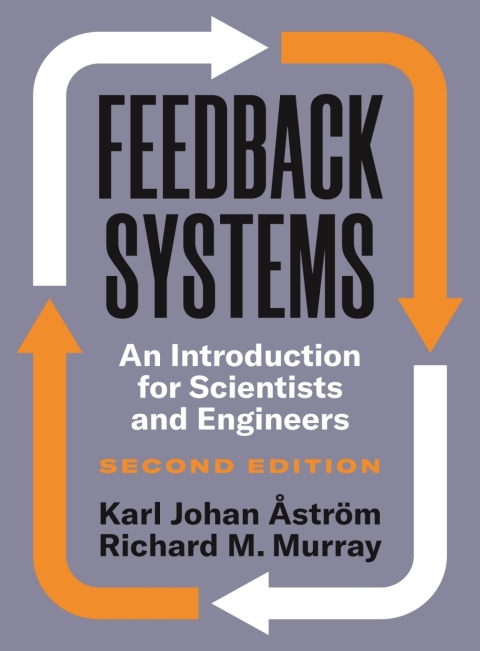Description
Efnisyfirlit
- Contents
- Preface to the Second Edition
- Preface to the First Edition
- 1. Introduction
- 1.1 What Is Feedback?
- 1.2 What is Feedforward?
- 1.3 What Is Control?
- 1.4 Uses of Feedback and Control
- 1.5 Feedback Properties
- 1.6 Simple Forms of Feedback
- 1.7 Combining Feedback with Logic
- 1.8 Control System Architectures
- 1.9 Further Reading
- Exercises
- 2. Feedback Principles
- 2.1 Nonlinear Static Models
- 2.2 Linear Dynamical Models
- 2.3 Using Feedback to Attenuate Disturbances
- 2.4 Using Feedback to Track Reference Signals
- 2.5 Using Feedback to Provide Robustness
- 2.6 Positive Feedback
- 2.7 Further Reading
- Exercises
- 3. System Modeling
- 3.1 Modeling Concepts
- 3.2 State Space Models
- 3.3 Modeling Methodology
- 3.4 Modeling Examples
- 3.5 Further Reading
- Exercises
- 4. Examples
- 4.1 Cruise Control
- 4.2 Bicycle Dynamics
- 4.3 Operational Amplifier Circuits
- 4.4 Computing Systems and Networks
- 4.5 Atomic Force Microscopy
- 4.6 Drug Administration
- 4.7 Population Dynamics
- Exercises
- 5. Dynamic Behavior
- 5.1 Solving Differential Equations
- 5.2 Qualitative Analysis
- 5.3 Stability
- 5.4 Lyapunov Stability Analysis
- 5.5 Parametric and Nonlocal Behavior
- 5.6 Further Reading
- Exercises
- 6. Linear Systems
- 6.1 Basic Definitions
- 6.2 The Matrix Exponential
- 6.3 Input/Output Response
- 6.4 Linearization
- 6.5 Further Reading
- Exercises
- 7. State Feedback
- 7.1 Reachability
- 7.2 Stabilization by State Feedback
- 7.3 Design Considerations
- 7.4 Integral Action
- 7.5 Linear Quadratic Regulators
- 7.6 Further Reading
- Exercises
- 8. Output Feedback
- 8.1 Observability
- 8.2 State Estimation
- 8.3 Control Using Estimated State
- 8.4 Kalman Filtering
- 8.5 State Space Controller Design
- 8.6 Further Reading
- Exercises
- 9. Transfer Functions
- 9.1 Frequency Domain Modeling
- 9.2 Determining the Transfer Function
- 9.3 Laplace Transforms
- 9.4 Block Diagrams and Transfer Functions
- 9.5 Zero Frequency Gain, Poles, and Zeros
- 9.6 The Bode Plot
- 9.7 Further Reading
- Exercises
- 10. Frequency Domain Analysis
- 10.1 The Loop Transfer Function
- 10.2 The Nyquist Criterion
- 10.3 Stability Margins
- 10.4 Bode’s Relations and Minimum Phase Systems
- 10.5 Generalized Notions of Gain and Phase
- 10.6 Further Reading
- Exercises
- 11. PID Control
- 11.1 Basic Control Functions
- 11.2 Simple Controllers for Complex Systems
- 11.3 PID Tuning
- 11.4 Integral Windup
- 11.5 Implementation
- 11.6 Further Reading
- Exercises
- 12. Frequency Domain Design
- 12.1 Sensitivity Functions
- 12.2 Performance Specifications
- 12.3 Feedback Design via Loop Shaping
- 12.4 Feedforward Design
- 12.5 The Root Locus Method
- 12.6 Design Example
- 12.7 Further Reading
- Exercises
- 13. Robust Performance
- 13.1 Modeling Uncertainty
- 13.2 Stability in the Presence of Uncertainty
- 13.3 Performance in the Presence of Uncertainty
- 13.4 Design for Robust Performance
- 13.5 Further Reading
- Exercises
- 14. Fundamental Limits
- 14.1 System Design Considerations
- 14.2 Bode’s Integral Formula
- 14.3 Gain Crossover Frequency Inequality
- 14.4 The Maximum Modulus Principle
- 14.5 Robust Pole Placement
- 14.6 Nonlinear Effects
- 14.7 Further Reading
- Exercises
- Bibliography
- Index







Reviews
There are no reviews yet.